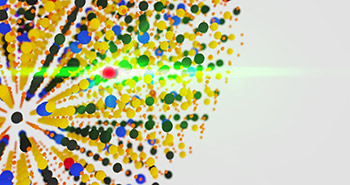
Researchers at the Molecular Foundry have discovered surprising new rules for creating ultra-bright light-emitting crystals that are less than 10 nanometers in diameter. These ultra-tiny but ultra-bright nanoprobes should be a big asset for biological imaging, especially deep-tissue optical imaging of neurons in the brain.
The multidisciplinary team of researchers led by James Schuck and Bruce Cohen used advanced single-particle characterization and theoretical modeling to study what are known as “upconverting nanoparticles” or UCNPs. Upconversion is the process by which a molecule absorbs two or more photons at a lower energy and emits them at higher energies. The research team determined that the rules governing the design of UCNP probes for ensembles of molecules do not apply to UCNP probes designed for single-molecules.

